This Austrian Hungarian Goulash is a delicious homage to my family’s culinary heritage, blending the best of both worlds. Inspired by my Austrian grandmother, who crafted this dish for my Hungarian grandfather, it marries the rich, saucy base of Austrian goulash with the chunky vegetables of the Hungarian version. Loaded with tender chunks of slowly simmered beef, potatoes, and carrots, this stew is comfort food at its finest—perfect for warming up on a cold day. And of course, no goulash would be complete without a generous dose of sweet Hungarian paprika!
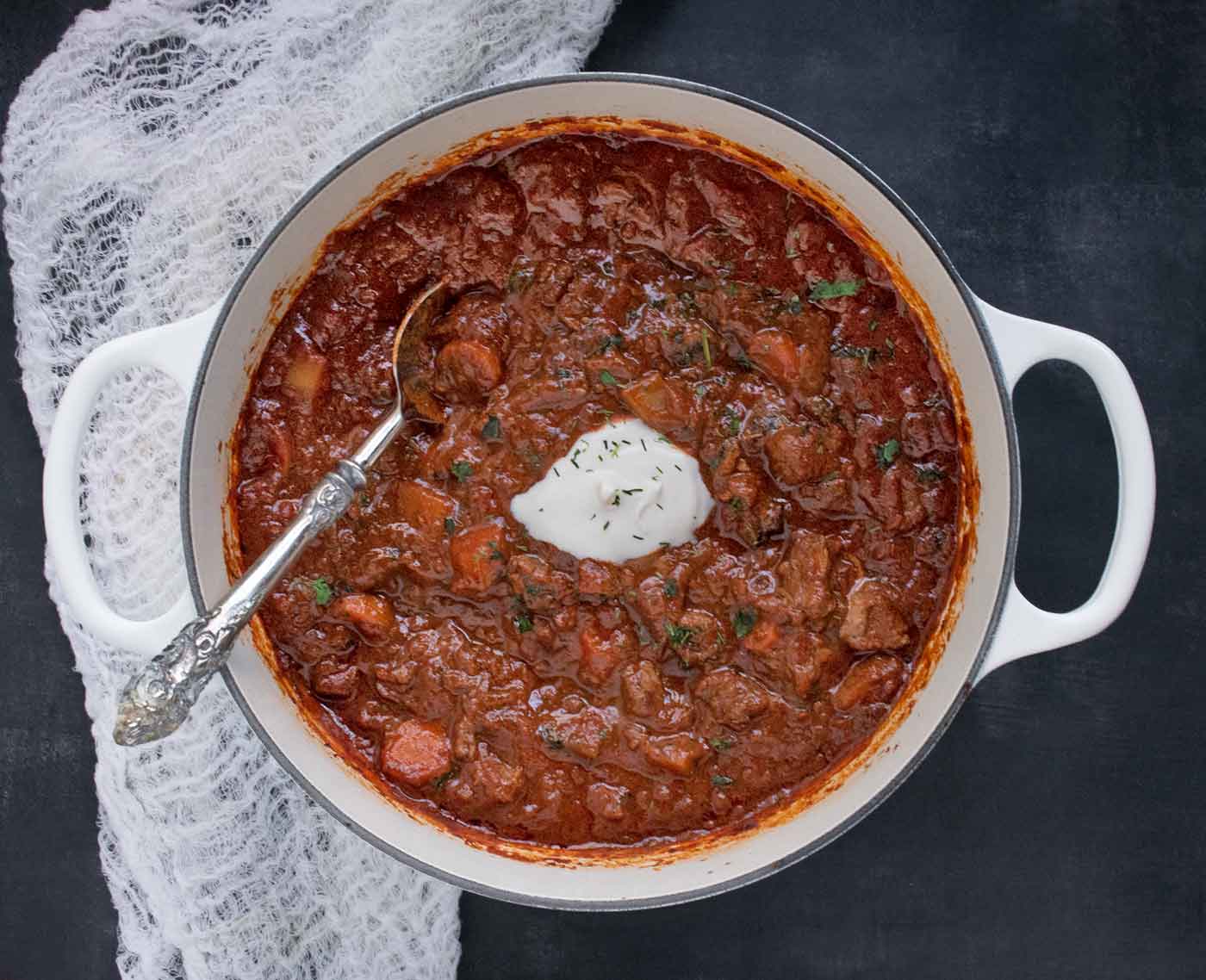
Why I love this goulash, and hope you will, too
So, SoupAddict, why the complicated recipe name? This version of goulash is actually my maternal grandmother’s and was passed down to my mom and became a childhood favorite.
My grandmother grew up in Austria, with her family’s Austrian version of goulash, which is basically just meat and onions in a thick, paprika gravy. My grandfather grew up in Hungary and enjoyed his mother’s version, which was distinctly soupier, with chunks of potatoes (and sometimes carrots).
When my grandparents married and moved to Budapest in the early 1900s, my grandmother had to adapt her own goulash history to my grandfather’s love of meat and potatoes. And so she created her own variation, which I’ve adapted to modern times, as I don’t cook with the beef tallow that she made and kept on hand (and also recipes in those days didn’t come with quantities because women cooked by memory and what they had available).
Reasons this stew is a hit at Casa SoupAddict:
Family-Inspired Recipe: A unique fusion of my grandparents’ Austrian and Hungarian traditions for a heritage-rich dish.
Flavor-Packed: Sweet Hungarian paprika infuses every bite with warmth and depth.
Hearty and Filling: Loaded with tender beef, onions, potatoes, and carrots, it’s a complete meal in one pot.
Perfect for Cold Days: This thick, comforting stew warms you up from the inside out.
Easy to Make Ahead: Goulash tastes even better the next day, making it ideal for meal prep or leftovers.
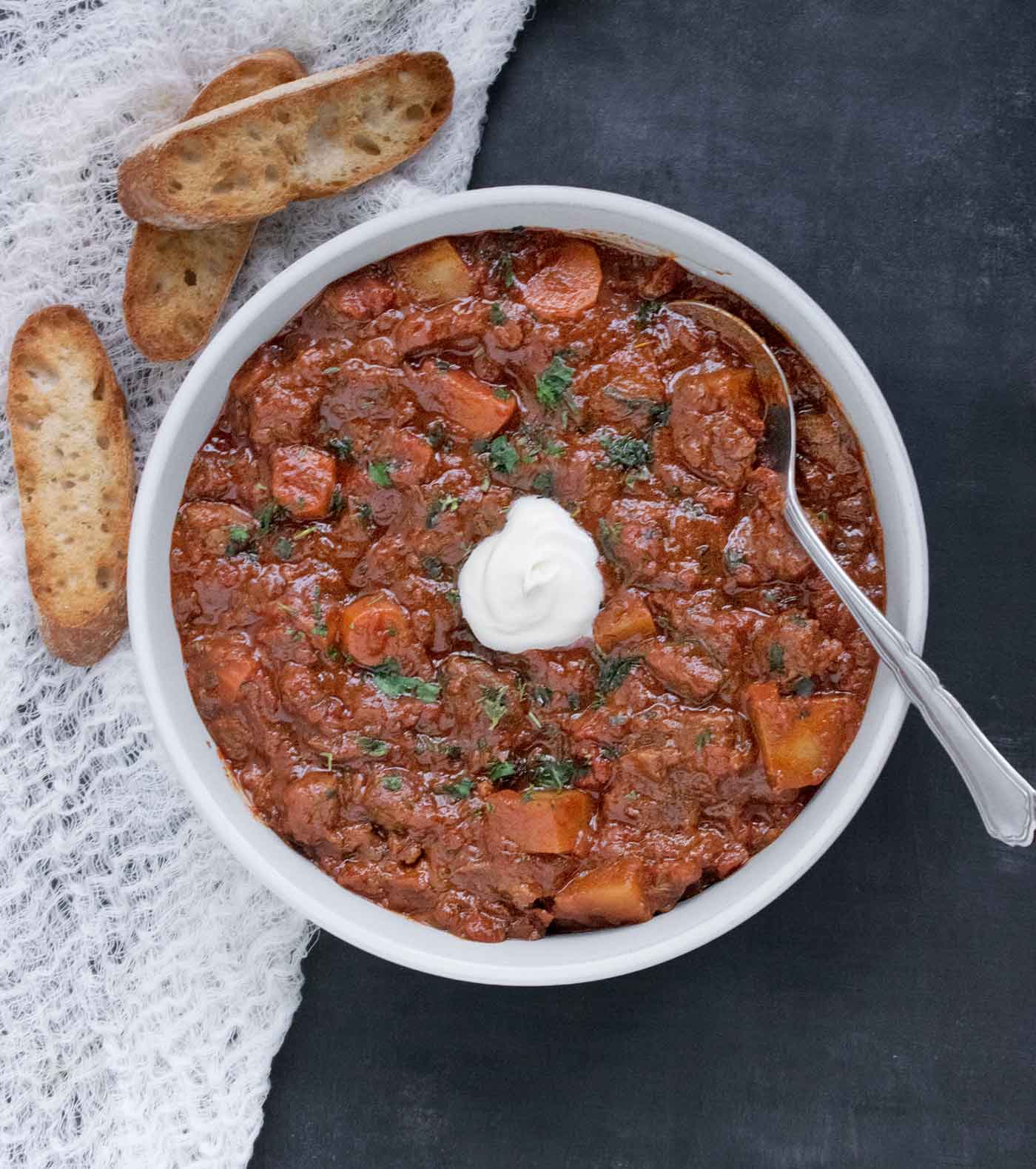
Main Ingredients and Substitutions
Beef chuck — Austrian Hungarian Goulash is a slow-cooking dish that uses cuts of beef with lots of connective tissue that needs to be broken down. The result is chunks of beef that practically fall apart on the fork. Chuck is probably the cut that’s most widely available in the U.S. Avoid cuts that we think of as steak, such as sirloin and ribeye, as they’re meant to be seared quickly and are tender even when cooked rare. Short ribs would be a good — although expensive — substitute.
Onions, carrots, potatoes — Onions are used in both Austrian and Hungarian versions, while carrots and potatoes are more likely to be found in Hungarian versions. I slice the onions thinly, as they’ll break down as the stew cooks, and cut the carrots and potatoes into 1/2″ chunks. This is 100% personal preference, but I cringe inwardly when I see photos of stews with huge chunks of veggies. This goulash is meant to be eaten with a spoon, and I don’t quite see the sense of, say, one chunk of carrot taking up the whole spoon.
Hungarian paprika — While sweet paprika should be easy to find in just about any grocery store, it might be worth hunting down authentic Hungarian sweet paprika, if you want to make this dish extra special.
Beef broth — Big-brand, store-bought beef broth is a bit problematic in the U.S., in that much of its flavoring comes from yeast extracts, sugars, and even sulfur. It might be worth splurging on a higher-end brand that emphasizes beef and/or beef bones. Check the ingredient labels to see what you’re comfortable with. Chicken broth is a fine substitute if your beef choices are iffy.
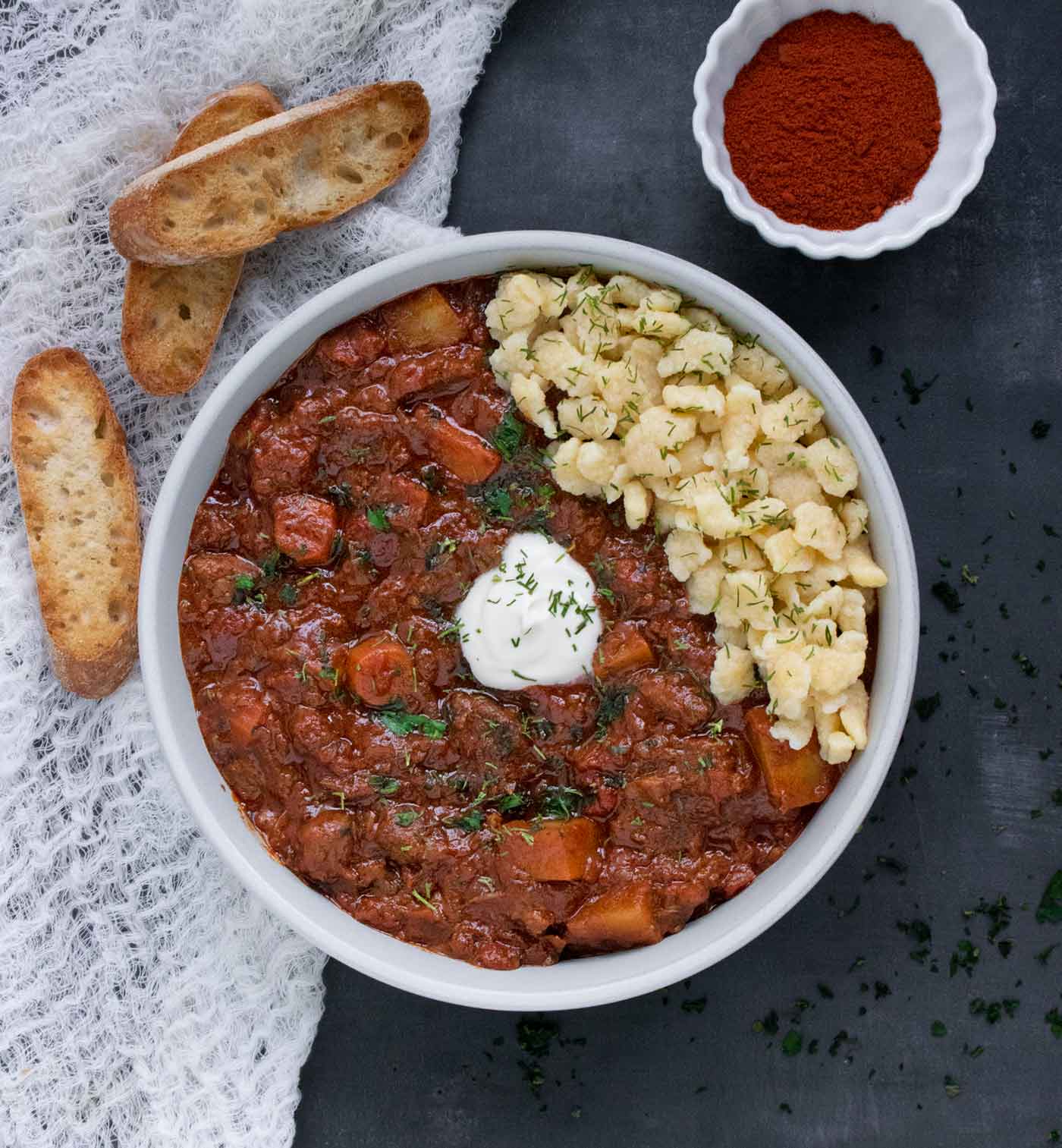
Cook’s Notes
- Did I read the recipe correctly, you might be thinking? Is that a 1/4 cup of sweet paprika? Lol, yes. It seems like an insane amount of paprika. And when you add it to the pot, it will look very wrong. But trust the process. It will all make sense when the rich, peppery sauce comes together.
- Can you use different paprikas in this recipe? Absolutely! If you and the fam are fans of spicy, add a little hot paprika to the sweet. I would not recommend completely replacing the sweet with the hot, but using both will be okay. Truth be told, I always sneak a teaspoon of smoked paprika – which is Spanish, not Hungarian — into this goulash, because I love the smoky notes.
- In my youth, when my mom took up the mantle of cooking my grandma’s goulash, she served it with wide egg noodles. My photos here show spaetzle noodles (little German dumplings), but that’s only because I decided to add them to my online order for the Hungarian paprika I purchased. Even though my hometown, Cincinnati, has strong German roots, spaetzle isn’t exactly a common item at the grocery store. Egg noodles are awesome and readily available (and for me, super nostalgic for this dish).
- As a soup chef who is very used to thinking a lot about a soup’s bite on the spoon when writing recipes, I’m put off by stews that use huge chunks of meat and vegetables. Even if one is eating a stew with a fork, I just don’t see the appeal of shoving an inch-and-a-half chunk of meat into one’s gob. I mean, even something like a New York strip steak is cut into bite-sized pieces, one at a time. So, for this goulash, I definitely recommend keeping everything fairly small — no larger than 3/4″ of an inch.
How to Make Austrian Hungarian Goulash
Ready to make the recipe? Skip to the recipe card now to get the full ingredient list, quantities, prep/cooking times, and detailed instructions. Or, keep scrolling for a visual walk-through of making the stew.
Pre-cook prep notes
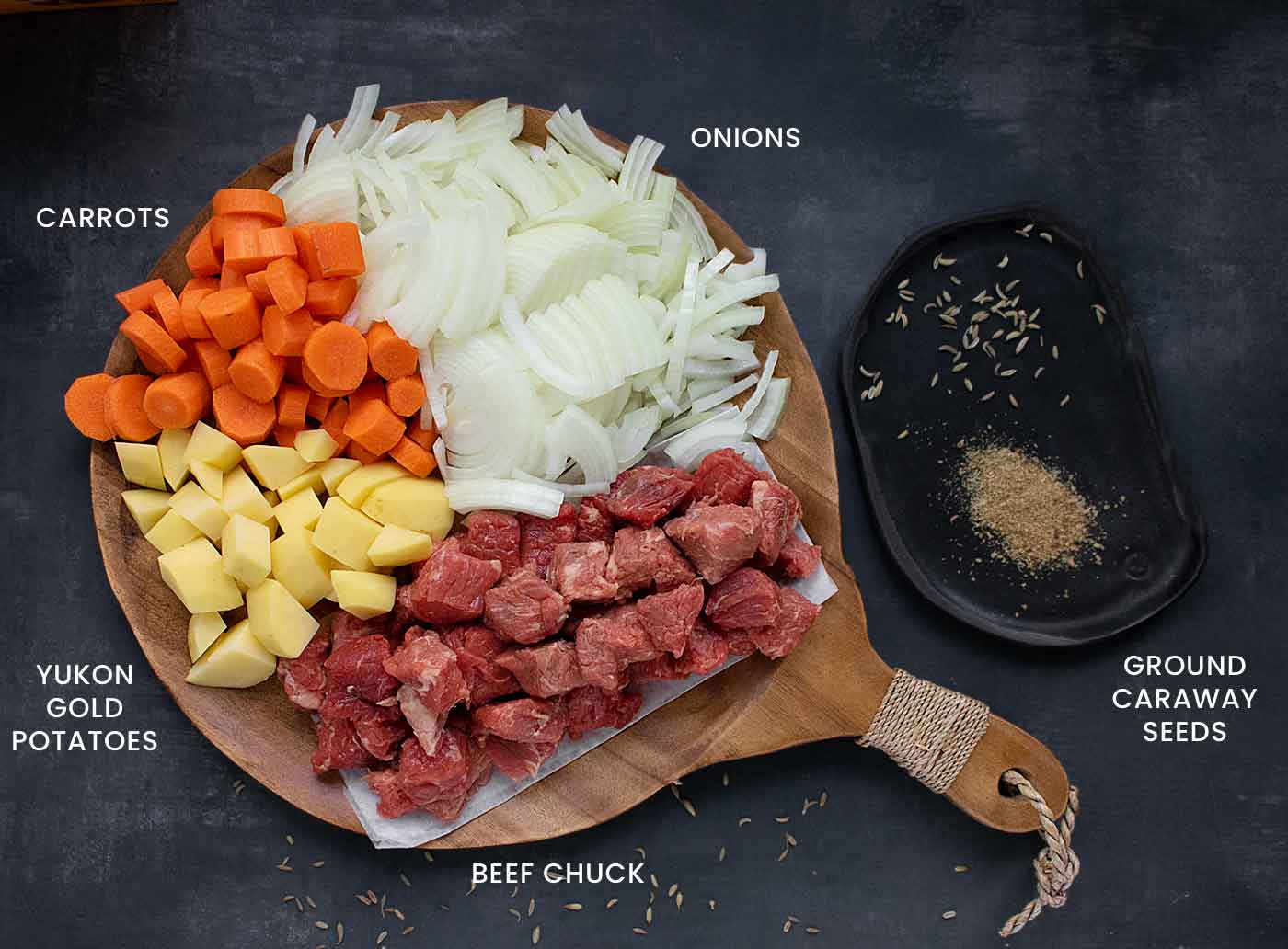
Here are some hopefully helpful guidelines for prepping the stew ingredients. Anything that simply needs to be measured out of a container – such as dried herbs and liquids – is not addressed here. Note that you can absolutely measure everything out into separate bowls or containers ahead of time. It’s a classic organizational technique called mise en place — literally, “everything in its place” — that helps the cooking workflow run smoothly.
- Slice the onions thinly into half or quarter moons
- Scrub and peel the carrots and potatoes, and chop them into 1/2″ chunks
- Cut the beef chuck into 1/2″ or 3/4″ pieces. You don’t need to trim the fat or connective tissue. Season the pieces with big pinches of salt and pepper.
- If your caraway seeds are whole, crush or grind them in a spice grinder or mortar and pestle.
Step 1: Brown the beef
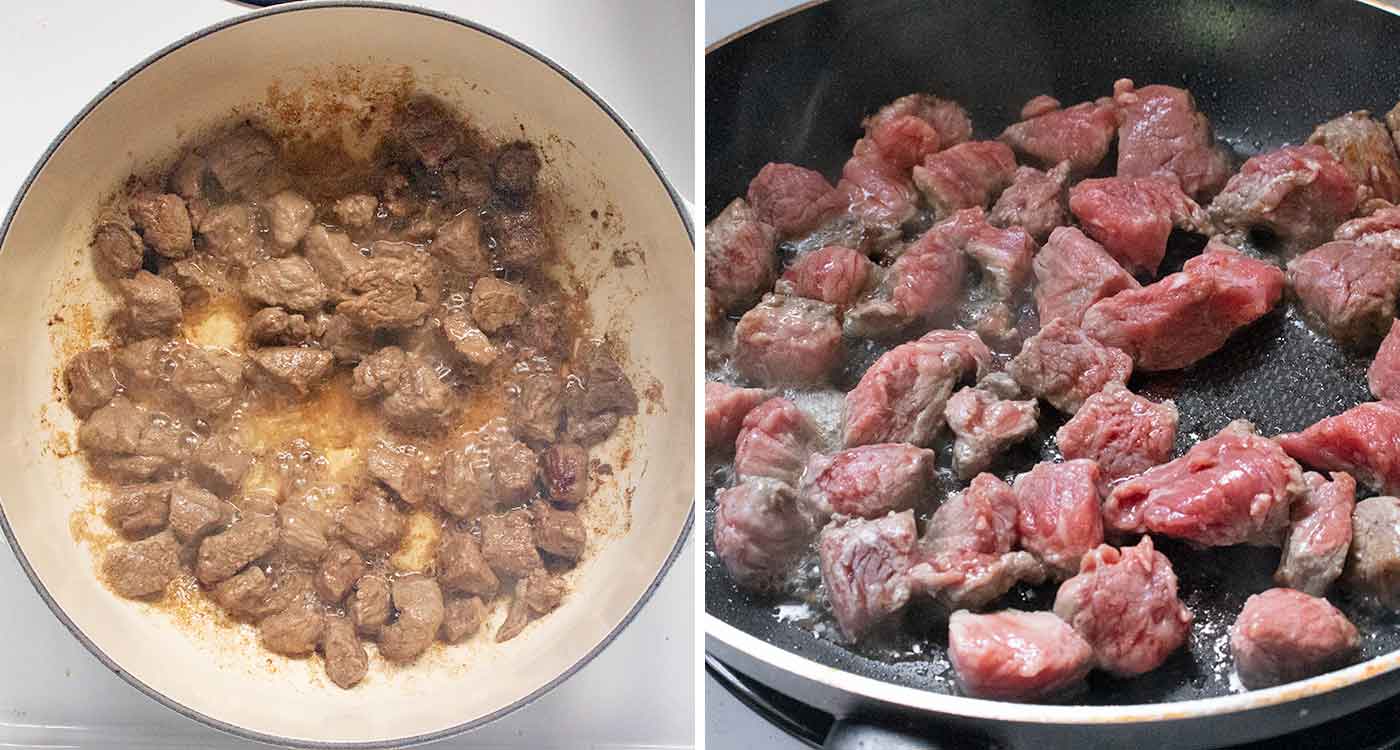
Heat the oil in a large pot and brown the beef on all sides. Transfer to a bowl. This will need to be done in batches.
Optionally, you can split the beef between the main soup pot and a separate skillet to save a good 10 or 15 minutes of cooking time (recommended, if you don’t mind washing an extra pan!).
Step 2: Cook the onions
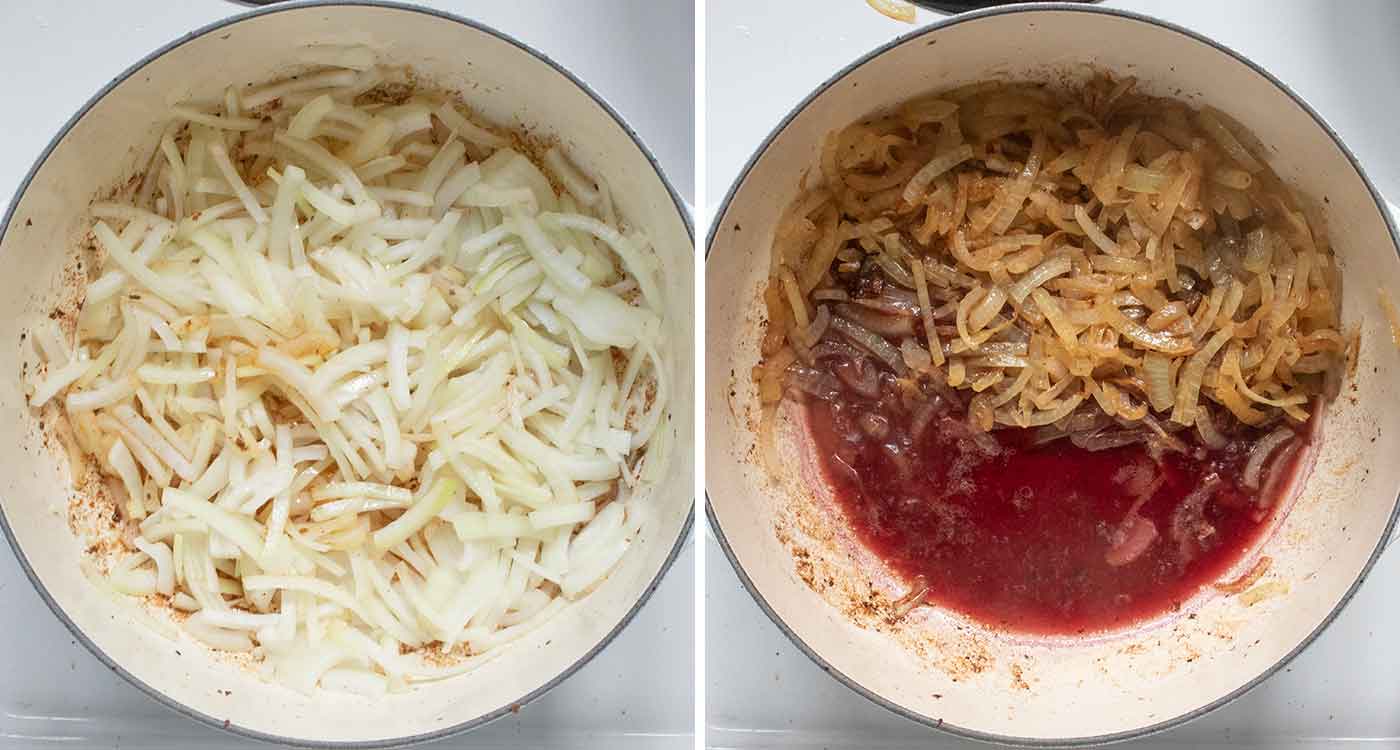
Add all of the onion slices to the pot with the beef drippings. Saute until soft and golden.
Pour in the red wine, and use a flat-edged spatula to scrape up the fond on the bottom of the pan.
Step 3: Add the seasonings

Return the beef to the pot, mixing well. Scootch everything to one side, and add a splash of the beef broth to the cleared area. Sprinkle the flour, marjoram, and caraway over the beef mixture, and spoon the tomato paste and Hungarian paprika over the broth in the cleared area.
Stir the paste and paprika together to create a paste, and then mix into the beef, stirring well. Add a little broth as you go to create a thick, saucy mixture.
Step 4: Cook the goulash

Add 2 cups of beef broth and the tomatoes and stir well. Raise the heat, cover with a lid, and cook for a total of 2 hours, checking often and stirring to ensure nothing burns on the bottom of the pan.
Step 5: Add the veggies

At the 45 to 60 minute mark, stir in the carrots, potatoes, and vinegar. If needed, pour in more beef broth so that both beef and veggies are almost completely covered. Cover again and continue the cook.
The goulash is ready when the beef is fork tender, and both the carrots and potatoes can be easily smashed against the side of the pot with a fork. The stew base should be thick, saucy, and glossy. If the goulash is too soupy, continue cooking with the lid off for another 10 minutes.
Serve over egg noodles with a big dollop of sour cream and a sprinkling of parsley and/or dill.
Storing
Austrian Hungarian Goulash is an excellent make-ahead meal. In fact, I recommend preparing it early enough in the day so that it can sit in the fridge for a few hours, allowing the flavors to continue to develop.
Store leftovers in an air-tight container in the refrigerator for up to 5 days. Goulash freezes well with the caveat that the potatoes might break down a bit after thawing and reheating. This will not affect the flavors.
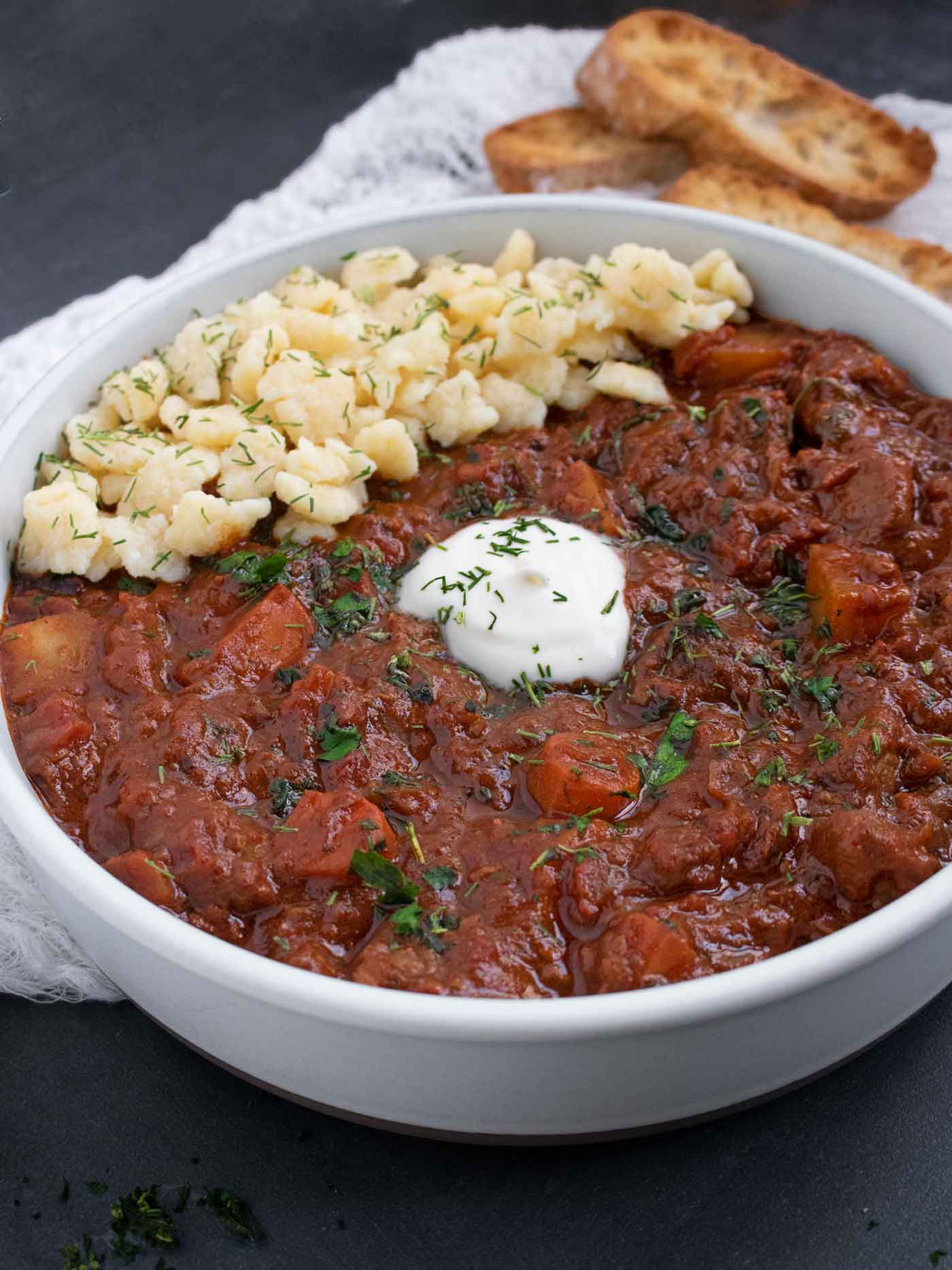
Austrian Hungarian Goulash is winter comfort food at its finest. Sweet paprika seasons a lovely, thick sauce that coats tender pieces of beef and vegetables. It’s always been a family favorite and I hope you and yours will enjoy it, too.

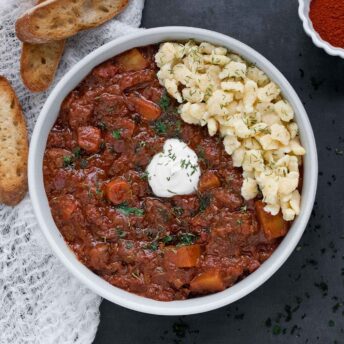
Austrian Hungarian Goulash
Ingredients
- 1 tablespoon neutral oil (such as vegetable) or butter
- 1 1/2 pounds stewing beef (such as chuck), cut into 3/4″ chunks
- 1 medium onion , sliced thinly into half or quarter moons
- 2 tablespoons red wine
- Kosher salt
- 3-4 cups beef broth*
- 2 tablespoons tomato paste
- 1 tablespoon all-purpose flour
- 1 teaspoon dried marjoram
- 1/2 teaspoon crushed or ground caraway seeds
- 4 tablespoons Hungarian sweet paprika
- 15 ounces petite diced tomatoes
- 1 cup carrots cut into 1/2″ chunks
- 1 cup Yukon gold potatoes , peeled and cut into 1/2″ chunks
- 1 tablespoon balsamic or apple cider vinegar
- Freshly ground black pepper.
- chopped parsley and dill , for garnish
- sour cream for garnish
Instructions
- Heat the oil in a 4 or 5 quart Dutch oven or soup pot over medium until the surface simmers. Season the beef with salt and pepper. Add part of the beef chunks, enough to form a single layer with a little empty space to move the chunks around. You probably won’t be able to cook the entire batch at once, so plan for two or three batches (or cook what won’t fit in a separate skillet at the same time). Cook until the chunks are browned on all sides, 5 to 10 minutes. Transfer to a bowl. Repeat with the remaining meat. After the last batch, leave the juices and fat from the meat in the pot.
- Add the onions and saute until soft and golden, stirring frequently. The juices from the onions will begin to loosen up any fond left behind from the meat.
- Pour in the red wine and stir into the onions, scraping up the fond with a flat spatula. Sprinkle a pinch of salt over the onions.
- Return the beef to the pot, along with any accumulated juices, and stir well into the onions.
- Scootch everything to the side. Sprinkle the flour, marjoram, and caraway seeds over the beef. Add a splash of your beef broth to the cleared area. Spoon the tomato paste and paprika into the cleared area and stir to create a paste. Add a little more broth if necessary to loosen the paste so that it’s almost sauce-like.
- Stir everything together. Add a splash of broth as necessary if the meat mixture gets too thick and pasty. It should be loose and saucy.
- Add two cups of beef broth and stir well. If necessary, add more broth so that it meets the level of the beef broth. Stir in the diced tomatoes with their juices.
- Raise the heat to bring the goulash to a gentle bubble — lots of bubbles breaking the surface, but not spitting or hissing. On my stove, this is just above the medium setting (not high). Cover the pot with the lid slightly ajar, and cook for 2 hours, checking on the pot every 20 minutes or so, to make sure it’s not boiling, or not bubbling enough.
- About 45 to 60 minutes into the cook, add the carrots, potatoes, and vinegar, stirring well. If the goulash is too “stewy” at this point — liquids not covering much of the meat — add another 1/2 cup of broth. Cover again with the lid ajar and continue cooking, stirring every 20 minutes or so.
- Carefully taste the goulash, including a piece of meat. Add salt and black pepper to taste. Also, it’s not at all traditional, but sometimes a teaspoon or two of brown sugar really livens up the goulash for American tastes.
- If possible, let the goulash cool and store in the refrigerator for several hours before reheating and serving, to let the flavors fully develop. This is a great make-ahead meal that’s even better overnight.


Michelle
Friday 20th of December 2024
I made this Austrian/Hungarian Goulash today and it's delicious! It's very close to how my grandmother makes it, which made the meal that much more special :) I substituted fennel for caraway and oregano for marjoram, the flavor was great. I also added 8 cloves of garlic and about 1 Tbs of honey. The potatoes were a little over cooked for my taste, next time I make this, I'll add them when there's only 30 min. of cook time left.
Thank you for such a great recipe, Karen!
Karen - SoupAddict
Friday 20th of December 2024
Thank you for your kind feedback, and I'm glad you able to tweak it to your tastes!
Barb
Wednesday 4th of December 2024
This sounds delicious, but what's the correct amount of paprika? Your notes say 1/4 cup (4T), but recipe is only calling for 2 Tablespoons.
Karen - SoupAddict
Wednesday 4th of December 2024
Good catch on the typo, thank you! It's 4 tablespoons. Recipe corrected.